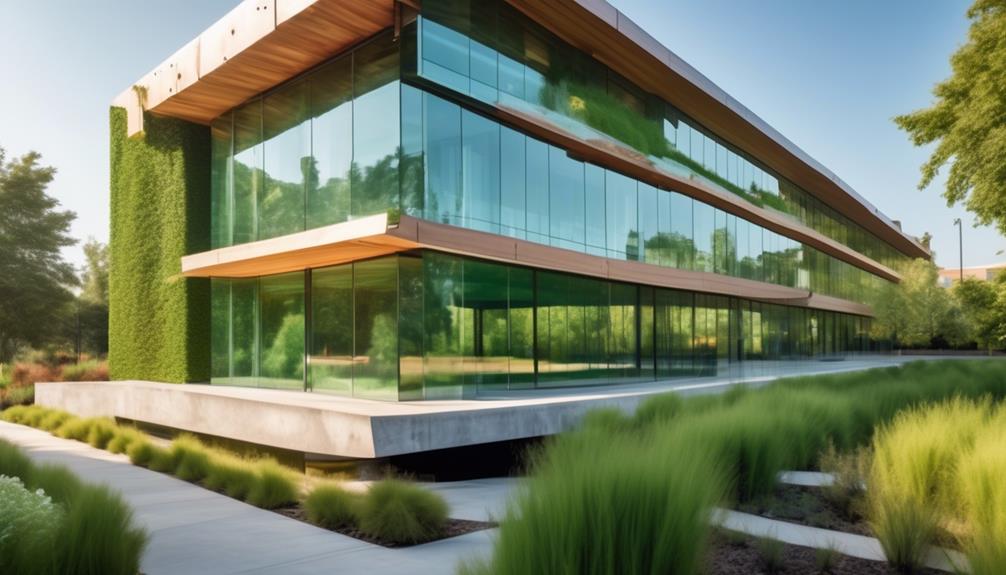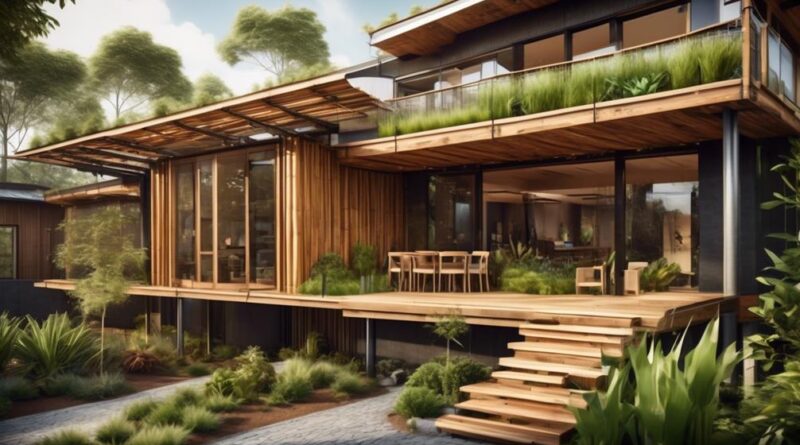8 Best Eco-Friendly Materials for Modern Construction
You've probably heard the saying, 'They don't make them like they used to.' When it comes to modern construction, this sentiment couldn't be further from the truth. Today, there are numerous eco-friendly materials that not only uphold the principles of sustainability but also offer innovative solutions for construction projects.
From bamboo to recycled steel, the options are diverse and promising. But what makes these materials stand out?
Let's explore the top eight eco-friendly materials for modern construction and how they are shaping the future of sustainable building practices.
Bamboo
When considering eco-friendly materials for modern construction, bamboo stands out as a versatile and sustainable option. Sustainable sourcing is a key feature of bamboo, as it's a fast-growing and renewable resource. Bamboo can be harvested without causing harm to the plant or its surrounding environment, making it an environmentally responsible choice. Additionally, bamboo forests have a positive impact on the planet by absorbing large amounts of carbon dioxide and releasing oxygen into the atmosphere. This sustainable sourcing aspect makes bamboo an attractive material for those looking to reduce their environmental footprint in construction projects.
In terms of structural integrity, bamboo is surprisingly strong and durable. It has a tensile strength that rivals steel, making it an excellent choice for construction purposes. The flexibility and strength of bamboo make it ideal for withstanding heavy loads and high winds, which is particularly important in areas prone to natural disasters. Its natural resilience reduces the need for additional chemical treatments or preservatives, further contributing to its eco-friendly nature.
Recycled Steel
Bamboo's exceptional strength and sustainability make it a popular choice in modern construction. However, when considering construction materials, it's important to acknowledge the significant environmental impact of steel production. Traditional steel production processes involve the extraction of iron ore and coal, which release large amounts of greenhouse gases and deplete natural resources.
Fortunately, innovative steel recycling methods have transformed the industry. Recycled steel offers a sustainable alternative by reducing the need for new steel production. By using scrap steel as a raw material, the energy and resources required for steel production are considerably minimized. This significantly lowers carbon emissions and lessens the demand for iron ore and coal mining.
Two commonly used innovative steel recycling methods are the electric arc furnace (EAF) and basic oxygen furnace (BOF) processes. The EAF utilizes scrap steel to produce new steel, while the BOF method combines recycled steel with a small amount of virgin materials to create high-quality steel. These methods not only reduce the environmental impact but also contribute to the conservation of natural resources.
Cork
Recycled steel offers a sustainable alternative by reducing the need for new steel production, and now let's explore the eco-friendly benefits of cork in modern construction.
Cork is a versatile and sustainable material that offers various benefits for eco-friendly construction. One of the key advantages of cork is its insulation properties. Cork insulation provides excellent thermal and acoustic insulation, helping to reduce energy consumption and minimize sound transmission within buildings. This not only enhances the comfort and energy efficiency of a structure but also contributes to a more sustainable and environmentally conscious construction approach.
In addition to its insulation benefits, cork also offers sustainable flooring options. Cork flooring is made from the bark of the cork oak tree, which can be harvested without causing harm to the tree itself. This sustainable harvesting method allows for the renewal of cork resources, making it an environmentally friendly flooring choice. Furthermore, cork flooring is durable, comfortable to walk on, and has natural sound-absorbing qualities, making it an excellent option for modern construction projects with a focus on sustainability and eco-friendliness.
Straw Bales
Straw bales offer a sustainable and cost-effective building material for modern construction projects, providing excellent insulation and structural support.
When it comes to insulation benefits, straw bales are exceptional at maintaining a comfortable indoor temperature. The tightly packed straw creates a natural barrier to heat transfer, keeping your home warm in the winter and cool in the summer. This can significantly reduce the need for artificial heating and cooling, leading to lower energy consumption and costs.
In addition to their insulation benefits, straw bales also provide remarkable structural integrity. When properly compressed and stacked, straw bales form a sturdy and durable wall system. The natural binding properties of straw, combined with clay or lime plasters, create a strong and resilient structure that can withstand the test of time. This makes them a reliable choice for modern construction, offering a viable alternative to traditional building materials.
Furthermore, using straw bales in construction promotes sustainability by utilizing a renewable agricultural byproduct that would otherwise go to waste. This eco-friendly approach not only reduces the environmental impact but also supports local farming communities. Incorporating straw bales into your construction projects aligns with the principles of green building, making it an attractive option for those seeking environmentally conscious solutions.
Rammed Earth
Rammed earth construction offers a durable and sustainable alternative for modern building projects, providing a natural and resilient material for structural walls. The benefits of using rammed earth in modern construction are multifaceted.
Firstly, rammed earth is an abundant and low-cost material, making it an attractive option for sustainable building practices. Its thermal mass properties also contribute to energy efficiency, as it naturally regulates indoor temperatures, reducing the need for heating and cooling. Additionally, the process of rammed earth construction minimizes the use of fossil fuels, as it primarily relies on labor-intensive techniques rather than heavy machinery, aligning with eco-friendly principles.
Sustainable building practices with rammed earth techniques extend beyond the construction phase. Rammed earth structures have a long lifespan, requiring minimal maintenance over the years. This durability reduces the need for frequent renovations or replacements, ultimately decreasing the environmental impact associated with building materials. Furthermore, rammed earth walls are non-combustible and resistant to pests, offering a natural form of protection without the use of additional chemical treatments.
Incorporating rammed earth into modern construction not only promotes sustainability but also celebrates the beauty of natural materials. The earthy tones and textures of rammed earth walls add a unique aesthetic to architectural designs, enhancing the overall visual appeal of sustainable buildings. Whether used for residential, commercial, or institutional projects, rammed earth construction stands as a testament to the harmony between modern innovation and environmentally conscious practices.
Hempcrete
You can easily incorporate hempcrete into modern construction projects, offering a sustainable and versatile material for various building applications. Hempcrete is a bio-composite material made of hemp hurds (woody inner fibers of the hemp plant) mixed with lime and water. It's gaining popularity as a sustainable insulation option due to its excellent thermal performance and minimal environmental impact.
Building with hemp fibers creates a lightweight and breathable material that provides natural insulation. Hempcrete regulates moisture, preventing mold growth and maintaining a healthy indoor environment. Its insulating properties contribute to energy efficiency, reducing the need for heating and cooling systems in buildings. Additionally, hempcrete has a negative carbon footprint, as the hemp plants absorb more carbon dioxide during growth than is emitted during the production and application of hempcrete.
When used in construction, hempcrete offers a range of benefits. It's non-toxic, pest-resistant, and fire-resistant, enhancing the overall safety and durability of structures. Hempcrete is also mold-resistant, making it an ideal choice for improving indoor air quality. Its versatility allows for various applications, including wall construction, insulation, and as a natural plaster material.
Recycled Glass

Using recycled glass in construction offers a sustainable and environmentally friendly alternative for various building applications. Recycled glass countertops are a popular choice for eco-conscious homeowners and businesses. These countertops are made from crushed, recycled glass held together with a binder, such as resin or cement. They offer a unique and visually appealing surface while contributing to environmental conservation.
The benefits of using recycled glass in construction are numerous. First and foremost, it helps divert glass waste from landfills, reducing the environmental impact of glass disposal. By repurposing glass that would otherwise take up space in landfills and require significant energy to melt down for recycling, using recycled glass in construction significantly reduces carbon emissions. Additionally, the vibrant colors and textures of recycled glass countertops add a distinctive touch to interior spaces, making them a stylish and sustainable choice for modern construction projects.
Furthermore, using recycled glass in construction promotes the concept of a circular economy, where materials are reused and repurposed, reducing the need for new resource extraction. This not only conserves natural resources but also minimizes the energy required for manufacturing new materials.
Cross Laminated Timber
A sustainable and versatile building material, cross laminated timber (CLT) offers numerous benefits for modern construction projects.
CLT is sourced from sustainably managed forests, making it an environmentally friendly option. The sustainable sourcing of CLT ensures that forests are responsibly managed, promoting the long-term health of ecosystems. This makes it an ideal choice for environmentally conscious construction projects.
Structural integrity is another key advantage of CLT. Due to its crosswise layering of timber, CLT has exceptional strength and stability. This allows for the construction of tall buildings and large structures using timber, which was previously limited to steel and concrete. The layers are bonded together with environmentally friendly adhesives, creating a solid and durable material that can withstand heavy loads and provide excellent thermal and acoustic insulation.
When considering the environmental impact of construction materials, the sustainable nature of CLT makes it an attractive choice. By using CLT, you're contributing to the reduction of carbon emissions and promoting the preservation of natural resources. Additionally, the structural integrity of CLT provides long-term stability and reliability for your construction projects.
Frequently Asked Questions
Can Bamboo Be Used for Structural Purposes in Modern Construction?
Yes, bamboo can be used for structural purposes in modern construction. Its strength and flexibility make it an excellent choice for sustainable building materials. You can utilize bamboo to create sturdy and eco-friendly structures.
How Is Recycled Steel Processed and Manufactured for Construction Use?
Recycled steel processing involves melting down scrap metal to produce new steel. This sustainable practice reduces environmental impact by saving energy and resources. The manufactured steel maintains structural integrity, making it ideal for construction use.
What Are the Limitations of Cork as a Construction Material?
When considering cork as a construction material, it's important to weigh the benefits and drawbacks. While cork is sustainable and offers sound insulation, its limitations include cost effectiveness and vulnerability to damage.
Are There Any Special Considerations for Using Straw Bales in Construction Projects?
When considering straw bale benefits, keep in mind that proper installation and moisture resistance are crucial. Check for local building codes and consult with professionals to ensure a successful and eco-friendly construction project.
What Are the Long-Term Durability and Maintenance Requirements for Hempcrete in Modern Construction?
When considering long-term strength and maintenance, hempcrete is a durable and sustainable choice for modern construction. Its environmental impact is minimal, making it an excellent option for eco-friendly building projects.
Conclusion
In conclusion, when it comes to modern construction, there are numerous eco-friendly materials to choose from.
Whether it's bamboo for its strength and sustainability, recycled steel for its durability, or hempcrete for its low environmental impact, these materials offer a greener alternative for building projects.
By incorporating these options into construction practices, we can reduce our carbon footprint and create more sustainable buildings for the future.
